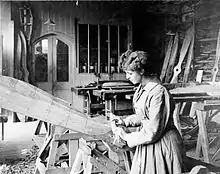Frederick Tibbenham
Frederick Tibbenham (1884 – 26 June 1947)[1] was a British cabinet maker and businessman from Ipswich, Suffolk. His company held a Royal Warrant for the production of furniture, and he also formed a construction company, working with some notable architects to design and build homes. During the two World Wars his factory made wooden aircraft propellors.
Work
Tibbenham started his working life as a picture framer.[2] He progressed to cabinet making, and in 1904, established the firm of Frederick Tibbenham Ltd, furniture makers in Ipswich.[3] In its workshops in Turret Lane, the company made high-quality reproduction pieces, particularly in "Jacobethan" (Tudor or Elizabethan) style,[4] which were frequently exported to the US. They were also involved in furniture restoration, and used both genuine and reproduction panelling in house restoration work.[4]

During World Wars I and II, Tibbenham switched the output of the factory to wooden propellers, of which there are a considerable number in private and public collections, and an equal number of photographs of the factory's manufacturing process. The firm also manufactured wooden Bren gun grips, butts and carrying handles as part of the war effort.[5] In 1916 Tibbenham was a director of the new London-based Tibbenham's Aviation Company Ltd, formed to promote the science or sport of flying and aerial locomotion, to manufacture and deal in aeroplanes, &c. [6] He also tried - unsuccessfully - to persuade the British army to commission the production of wooden bullets.
Between the World Wars, Tibbenham branched into construction in partnership with a number of notable architects, and as the Tibbenham Construction Company, (architect Stanley Hamp) exhibited a cottage at the 1926 Daily Mail Ideal Home Exhibition. Tibbenham had earlier trialed the building methods with Oakhurst and Tudor House in Northwood, Middlesex, a pair of Arts & Crafts oak-framed houses on the Copsewood estate, which are two of the total of only four Tibbenham buildings known to have been built by the Tibbenham Construction Company, and which are now Locally Listed. In 2010 Oakhurst came under threat of demolition by a developer, with campaigners attempting to save it, but in September 2012 permission was granted to demolish the house; demolition is scheduled for September 2013.[7] Another building, the clubhouse for Ipswich Golf Club, opened in 1927, was built on a not-for-profit basis by Tibbenham for £3200.[8] In 1934 Tibbenham was on the board of Frinton Park Estate Limited, the management company for an ambitious Art Deco development planned between Frinton-on-Sea and Walton-on-the-Naze which was intended to be a showcase for British design.[9] It was Tibbenham who introduced the architect Oliver Hill to his colleagues on the board. The estate Hill envisaged was only partially finished and the company collapsed, but it is still one of the country's largest collections of Art Deco houses.[10]
After the Second World War, Tibbenham was obliged to alter the production of the factory to 'Utility' pieces, which failed to keep the factory working. Attempts to keep the business viable included the purchase of the McLagan Furniture Company of Stratford, Ontario in 1948, but the company closed this venture within three years of acquiring it.[11] Tibbenham's itself closed in the mid-1950s, having suffered the effects of the new purchase tax, after being a subject of a debate in the House of Commons. [12]
References
- Source: 1911 census, ref RG14PN10826 RG78PN585 RD213 SD2 ED1 SN279
- Source: 1901 census
- Kindred, David (22 April 2008). "Doing their bit for the war effort". Ipswich Star. Retrieved 2 August 2012.
- "Door and doorway". V &A Museum collections. Retrieved 1 August 2012.
- "The Bren gun". www.archivingindustry.com. Archived from the original on 15 January 2013. Retrieved 2 August 2012.
- "New companies registered". Flight. 7 December 1916. Retrieved July 1, 2012.
- Matti, Siba (22 September 2010). "Oakhurst's fate in the balance". Uxbridge Gazette. Retrieved 1 August 2012.
- "A brief history of Ipswich Golf Club". Retrieved 1 August 2012.
- Oxborrow, Kelly. The Bauhaus, modernism & domestic architecture, Ch.3. Cited at Frinton Park Estate, www.frinton.org. Accessed 1 August 2012.
- Clark, Ross (19 July 2003). "Joke over for the last resort". Daily Telegraph. Retrieved 1 August 2012.
- Jacob, Kate (8 May 2010). "Chair maker had long run in Stratford". Stratford Beacon-Herald. Retrieved 1 August 2012.
- Retrieved on 1 July 2012. Mr Albert Cooper (Ilford South), contribution to Parliamentary debate on Purchase Tax, 15 Nov 1955
External links
- A woman fitter working on an aeroplane propeller at Frederick Tibbenham Ltd in Ipswich. Photograph from the Imperial War Museum photographic archive, hosted at the First World War Digital Poetry Archive, University of Oxford. Accessed 1 August 2012.
- London Gazette entry of death
- facebook page about some of his work